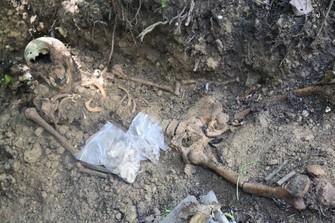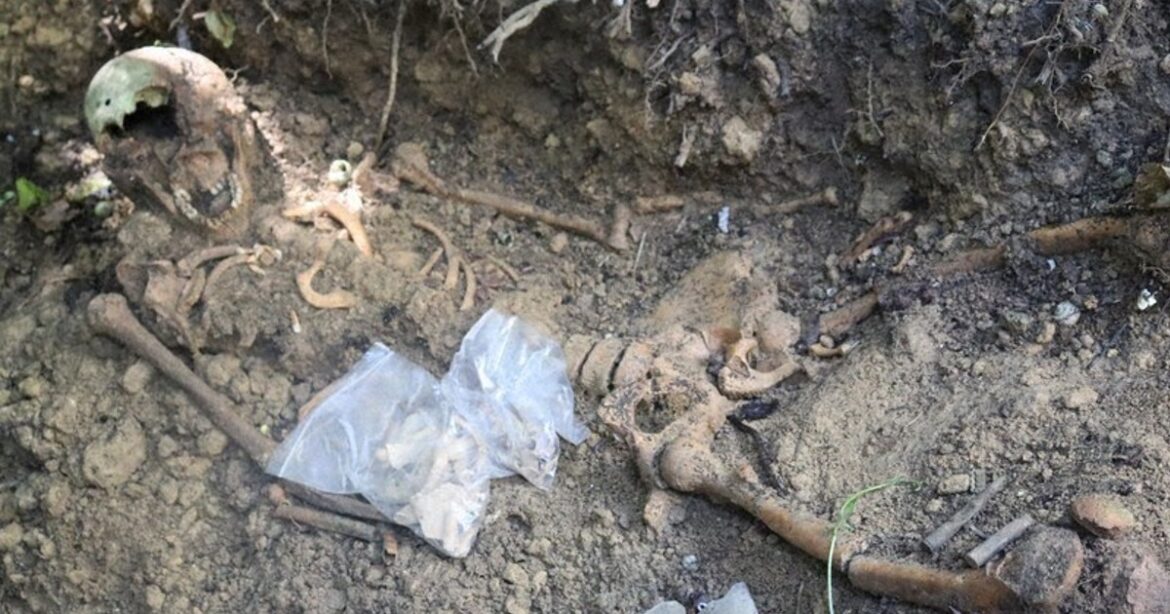
The almost entire skeletal remains of a war dead person are seen in Itoman, Okinawa Prefecture, after their discovery in April 2025, in this photo taken on June 23, 2025. They are believed to belong to a young soldier aged around 20 at the time. (Mainichi/Toshio Kurihara)
Sayoko Yamamoto, an 81-year-old resident of Hyogo Prefecture, has never seen her father. He was drafted to war in December 1943, six months before she was born, and reportedly died in a field hospital in Burma, present-day Myanmar, the following year. A government notice of his death in battle arrived two years after the end of World War II, but a white wooden box his family received only contained a piece of wood.
Her parents’ married life lasted just a little over four months, and few could share their memories and mementos of her father. As Yamamoto got older, her desire to know the truth about her dad, who passed away at age 26, grew. She examined his war records and family registry to follow in his footsteps.
Yamamoto believes that if only her family had received her father’s remains, they could have served as mementos to remember the deceased kin. “I miss my dad, who remains buried in a foreign land. To me, the war has not ended yet,” she told the Mainichi Shimbun.
During World War II, approximately 3.1 million people of Japan died. Of them, roughly 2.4 million perished overseas, or in Okinawa or Iwo Jima (now Ioto Island), but the remains of only around 1.28 million individuals are said to have been retrieved. Of the remainder, the Japanese government considers the remains of about 590,000 people as “retrievable,” except for those that are sunk at sea.
Retrieval becoming more difficult
The work to recover the remains of the war dead began in 1952, the year Japan restored its sovereignty. From the very beginning, however, the government’s stance was that “it is impossible to bring all of them back.” The retrieval work has since continued, with the bereaved families protesting every time the government suggested discontinuing it. It was not until 2016 that a lawmaker-sponsored bill stipulating the retrieval as a state responsibility was passed into law.
The investigation system has since been strengthened and budgets increased. However, it is becoming more difficult to discover the remains as time passes. Over the nine-year period up to fiscal 2024, the remains of fewer than 4,000 people were newly collected.
According to the Ministry of Health, Labor and Welfare, there are approximately 3,000 locations overseas where the remains of the war dead are said to have been left but no investigation has been carried out yet. There is an urgent need to act while approaching other countries hosting those sites.
The original objective of the retrieval work is to identify the remains and return them to their relatives. In recent years, an examination method of extracting DNA samples from teeth, femurs and other parts of the bodies of the war dead and comparing them with those of their kin has proven successful in determining their blood relationship.
While the government had long limited this method to cases where there were personal belongings that could help identify the fallen, it relaxed the conditions in 2016 and expanded the coverage to all remains in 2021. Consequently, the remains of more than 20 people have been returned to their families from Okinawa and the southern fronts, where the personal effects of the war dead are rarely found.
There are remains of more than 13,000 people from which DNA samples have been collected. The government should widely publicize information such as where those remains were recovered and whether they accompanied personal belongings, to make the data more accessible to bereaved families.

A researcher is seen inside a lab at Shinshu University in Matsumoto, Nagano Prefecture, on June 23, 2025. The medical school of the university has entered into an agreement with the Ministry of Health, Labor and Welfare and has been engaged in DNA analysis of the remains of the war dead. Genes extracted from the bones are analyzed in this lab. (Mainichi/Yoshiya Goto)
It has also proven effective to approach the surviving families. In 2020, the welfare ministry sent out notices to some 2,700 relatives of those who perished on the Tarawa Atoll in Kiribati in the central Pacific as part of a pilot project to call for DNA testing. Of them, some 400 relatives came forward, leading to identifying two victims.
The government is against expanding this initiative to other areas, citing excessive burdens on local bodies to be tasked with the family searches. However, in some former battlefields the scope of the families subject to the searches could be narrowed down based on the troops their kin belonged to. The government is urged to pursue effective methods and continue approaching the relatives.
Witnesses to the reality of the war’s devastation
In Japan, there are also many victims of atomic bombings and air raids whose remains have not been found. In the aftermath of the Great Tokyo Air Raids in 1945, the bodies of victims were tentatively buried at some 150 locations according to records, but more than half of these sites have not been identified. The government must extend support to civil groups that have continued investigations throughout the country.
An issue has also arisen where the remains of those who died in the 1945 Battle of Okinawa are treated carelessly.
The Ministry of Defense’s Okinawa Defense Bureau has cited the southern part of Okinawa’s main island, where fierce battles took place during the war, as a candidate site for collecting soil for the land reclamation work off the Henoko district of Nago, Okinawa Prefecture, for the construction of a U.S. military base there. Although the governor of Okinawa and the prefectural assembly have urged that any soil containing the remains of the war dead be not used in the project, the ministry has stopped short of clarifying its stance, stating, “We haven’t decided on where to procure the soil from.”
Photojournalist Natsuki Yasuda has compared the history of Okinawa with the realities facing people in Fukushima Prefecture who have been unable to search for the bodies of their loved ones who lost their lives to the tsunami in the wake of the 2011 Great East Japan Earthquake, as the families remain evacuated from their hometowns due to the nuclear disaster. “Is it right to achieve ‘recovery’ based on someone else’s sacrifice? I don’t think a nation that disregards the deceased and their remains can protect the dignity of people alive today.”
The remains of the fallen are “witnesses” to history.
In April this year, a group of volunteers unearthed the remains of an almost entire body in the mountains of Itoman, Okinawa Prefecture. The remains are thought to belong to a young soldier who was buried amid an intense battle.
The late anthropologist Shuichiro Narasaki, a leading expert in examining human remains, wrote down that in some cases the circumstances leading up to the person’s death could be conjectured based on the condition of their bones and personal effects.
We must learn lessons from the realities of the war as told by the remains of the fallen, and ensure our pledges against war.


AloJapan.com